The Role of Rheology and Fault Geometry on Fault Reactivation: A Case-Study from the Zsámbék-Mány Basin, Central Hungary
Abstract
1. Introduction
2. Geology of the Study Area
3. Methods and Data
4. Structure of the Zsámbék–Mány Basin
4.1. Structure of the Mesozoic Basement: Geometry of the Vértessomló (VT) Thrust
4.2. Basin-Bounding Faults of the Paleogene Deposits: The Környe-Zsámbék (KZ) Fault
4.3. Miocene Normal Faults
5. Discussion and Conclusions
5.1. Correlation of the VT Thrust and the KZ Fault: Comparison with Previous Works
5.2. The Role of Fault Geometry and Rheology on Fault Reactivation
Author Contributions
Funding
Acknowledgments
Conflicts of Interest
References
- Peron-Pinvidic, G.; Fourel, L.; Buiter, S.J.H. The influence of orogenic collision inheritance on rifted margin architecture: Insights from comparing numerical experiments to the Mid-Norwegian margin. Tectonophysics 2022, 828, 229273. [Google Scholar] [CrossRef]
- Tavarnelli, E. Normal faults in thrust sheets: Pre-orogenic extension, post-orogenic extension, or both? J. Struct. Geol. 1999, 21, 1011–1018. [Google Scholar] [CrossRef]
- Tari, G.; Bada, G.; Beidinger, A.; Csizmeg, J.; Danišik, M.; Gjerazi, I.; Grasemann, B.; Kovác, M.; Plašienka, D.; Šujan, M.; et al. The connection between the Alps and the Carpathians beneath the Pannonian Basin: Selective reactivation of Alpine nappe contacts during Miocene extension. Glob. Planet. Change 2021, 197, 103401. [Google Scholar] [CrossRef]
- Maffione, M.; Thieulot, C.; van Hinsbergen, D.J.J.; Morris, A.; Plümper, O.; Spakman, W. Dynamics of intraoceanic subduction initiation: 1. Oceanic detachment fault inversion and the formation of supra-subduction zone ophiolites. Geochem. Geophys. Geosyst. 2015, 16, 1753–1770. [Google Scholar] [CrossRef]
- Beauchamp, W.; Barazangi, M.; Demnati, A.; El Alji, M. Intracontinental rifting and inversion: Missour Basin and Atlas Mountains, Morocco. AAPG Bull. 1996, 80, 1459–1482. [Google Scholar]
- Butler, R.W.H.; Tavarnelli, E.; Grasso, M. Structural inheritance in mountain belts: An Alpine–Apennine perspective. J. Struct. Geol. 2006, 28, 1893–1908. [Google Scholar] [CrossRef]
- Carrera, N.; Muñoz, J.A. Thick-skinned tectonic style resulting from the inversion of previous structures in the southern Cordillera Oriental (NW Argentine Andes). In Thick-Skin-Dominated Orogens: From Initial Inversion to Full Accretion; Nemčok, M., Mora, A., Cosgrove, J.W., Eds.; Geological Society, London, Special Publications: London, UK, 2015; Volume 377, pp. 77–100. [Google Scholar]
- Héja, G.; Ortner, H.; Fodor, L.; Németh, A.; Kövér, S. Modes of oblique inversion: A case study from the Cretaceous fold and thrust belt of the western Transdanubian Range (TR), West Hungary. Tectonics 2022, 41. [Google Scholar] [CrossRef]
- Mescua, J.F.; Gambiagi, L.B. Fault inversion vs. new thrust generation: A case study in the Malargüe fold-and-thrust belt, Andes of Argentina. J. Struct. Geol. 2012, 35, 51–63. [Google Scholar] [CrossRef]
- Pace, P.; Calamita, F. Push-up inversion structures vs. fault-bend reactivation anticlines along oblique thrust ramps: Examples from the Apennines fold-and-thrust belt (Italy). J. Geol. Soc. 2013, 171, 227–238. [Google Scholar] [CrossRef]
- Tari, G.; Arbouille, D.; Schléder, Z.; Tóth, T. Inversion tectonics: A brief petroleum industry perspective. Solid Earth 2020, 11, 1865–1889. [Google Scholar] [CrossRef]
- Butler, R.W.H. The influence of pre-existing basin structure on thrust system evolution in the western Alps. In Inversion Tectonics; Cooper, M.A., Williams, G.D., Eds.; Geological Society, London, Special Publications: London, UK, 1989; Volume 44, pp. 105–122. [Google Scholar] [CrossRef]
- Calamita, F.; Pace, P.; Scisciani, V.; Properzi, F.; Francioni, M. Dinaric up-thrusts in the Pliocene evolution of the Central Apennines thrust belt of Italy: The Montagna dei Fiori structure. Geol. Mag. 2021, 158, 2063–2078. [Google Scholar] [CrossRef]
- Pace, P.; Pasqui, V.; Tavarnelli, E.; Calamita, F. Foreland-directed gravitational collapse along curved thrust fronts: Insights from a minor thrust-related shear zone in the Umbria-Marche belt, central-northern Italy. Geol. Mag. 2017, 154, 381–392. [Google Scholar] [CrossRef]
- Tavarnelli, E.; Scisciani, V.; Patruno, S.; Calamita, F.; Pace, P.; Iacopini, D. The role of structural inheritance in the evolution of fold-and-thrust belts: Insights from the Umbria-Marche Apennines, Italy. In 250 Million Years of Earth History in Central Italy: Celebrating 25 Years of the Geological Observatory of Coldigioco; Koeberl, C., Bice, D.M., Eds.; GSA Special Papers; Geological Society of America: Boulder, CO, USA, 2019; Volume 542, pp. 191–211. [Google Scholar] [CrossRef]
- Avouac, J.-P.; Ayoub, F.; Wei, S.; Ampuero, J.-P.; Meng, L.; LePrince, S.; Jolivet, R.; Duputel, Z.; Helmberger, D. The 2013, Mw 7.7 Balochistan earthquake, energetic strike-slip reactivation of a thrust fault. Earth Planet. Sci. Lett. 2014, 391, 128–134. [Google Scholar] [CrossRef]
- Sato, H.; Kato, N.; Abe, S.; Van Horne, A.; Takeda, T. Reactivation of an old plate interface as a strike-slip fault in a slip-partitioned system: Median Tectonic Line, SW Japan. Tectonophysics 2015, 644–645, 58–67. [Google Scholar] [CrossRef]
- Palotai, M.; Csontos, L. Strike-slip reactivation of a Paleogene to Miocene fold and thrust belt along the central part of the Mid-Hungarian Shear Zone. Geol. Carpathica 2010, 61, 483–493. [Google Scholar] [CrossRef]
- Timar-Geng, Z.; Grujic, D.; Rahn, M. Deformation at the Leventina-Simano nappe boundary, Central Alps, Switzerland. Eclogae geol. Helv. 2004, 97, 265–278. [Google Scholar] [CrossRef]
- Schmid, S.M.; Fügenschuh, B.; Kounov, A.; Maţenco, L.; Nievergelt, P.; Oberhänsli, R.; Pleuger, J.; Schefer, S.; Schuster, R.; Tomljenović, B.; et al. Tectonic units of the Alpine collision zone between Eastern Alps and western Turkey. Gondwana Res. 2020, 78, 308–374. [Google Scholar] [CrossRef]
- Fodor, L.; Csontos, L.; Bada, G.; Gyorfi, I.; Benkovics, L. Tertiary Tectonic Evolution of the Pannonian Basin System and Neighbouring Orogens: A New Synthesis of Palaeostress Data; Geological Society, Special Publications: London, UK, 1999; Volume 156, pp. 295–334. [Google Scholar] [CrossRef]
- Tari, G. Alpine Tectonics of the Pannonian Basin. Ph.D. Thesis, Rice University, Houston, TX, USA, 1994; p. 501. [Google Scholar]
- Schmid, S.M.; Bernoulli, D.; Fügenschuh, B.; Matenco, L.; Schefer, S.; Schuster, R.; Tischler, M.; Ustaszewski, K. The Alpine-Carpathian-Dinaridic orogenic system: Correlation and evolution of tectonic units. Swiss J. Geosci. 2008, 101, 139–183. [Google Scholar] [CrossRef]
- Fodor, L.; Csillag, G.; Lantos, Z.; Budai, T.; Kercsmár, Z.S.; Selmeczi, I. Geological Map of the Vértes Hills; Geological Institute of Hungary: Budapest, Hungary, 2008. [Google Scholar]
- Fodor, L.; Magyari, A.; Fogarasi, A.; Palotás, K. Tertiary tectonics and Late Palaeogene sedimentation in the Buda Hills, Hungary. A new interpretation of the Buda Line. Földtani Közlöny 1994, 124, 129–305. [Google Scholar]
- Császár, G.; Csereklei, E.; Budai, T. Geological Map of Hungary Scale 1:100 000, L–34–14 Érd (Bicske); Geological Institute of Hungary: Budapest, Hungary, 2004. [Google Scholar]
- Budai, T.; Fodor, L.; Kercsmár, Z.; Lantos, Z.; Csillag, G.; Selmeczi, I. Geological Map of the Gerecse Mountains, 1:50 000; Mining and Geological Survey of Hungary: Budapest, Hungary, 2018. [Google Scholar]
- Wein, G. Budai-Hegység Fedetlen Földtani Térkép 1:25000 (Translated Title: Pre-Quaternary Geological Map of the Buda Hills); Geological Institute of Hungary: Budapest, Hungary, 1976. [Google Scholar]
- Haas, J.; Budai, T. Upper Permian—Triassic facies zones in the Transdanubian Range. Riv. Ital. Paleontol. Stratigrafia 1995, 101, 249–266. [Google Scholar]
- Haas, J.; Budai, T. Triassic sequence stratigraphy of the Transdanubian Range (Hungary). Geol. Carpathica 1999, 50, 459–475. [Google Scholar]
- Budai, T.; Vörös, A. The Middle Triassic events of the Transdanubian Central Range in the frame of the Alpine evolution. Acta Geol. Hung. 1993, 36, 3–13. [Google Scholar]
- Budai, T.; Vörös, A. Middle Triassic platform and basin evolution of the Southern Bakony Mountains (Transdanubian Range, Hungary). Riv. Ital. Paleontol. Stratigr. 2006, 112, 359–371. [Google Scholar]
- Budai, T. Middle Triassic basin facies and volcanites in the Zsámbék Basin, Transdanubian Range, Hungary. Annu. Rep. Hung. Geol. Inst. 2004, 2002, 189–194, (In Hungarian, with English abstract). [Google Scholar]
- Budai, T.; Haas, J.; Piros, O. New stratigraphic data on the Triassic basement of the Zsámbék Basin—Tectonic inferences. Földtani Közlöny 2015, 145, 247–257. Available online: https://ojs3.mtak.hu/index.php/foldtanikozlony/article/view/134 (accessed on 1 September 2015). (In Hungarian, with English abstract).
- Dunkl, I.; Farics, É.; Józsa, S.; Lukács, R.; Haas, J.; Budai, T. Traces of Carnian volcanic activity in the Transdanubian Range, Hungary. Int. J. Earth Sci. 2019, 108, 1451–1466. [Google Scholar] [CrossRef]
- Haas, J.; Budai, T. Stratigraphic and facies problems of the Upper Triassic in the Transdanubian Range. Reconsideration of old problems on the basis of new results. Földtani Közlöny (In Hungarian, with English abstract). 2014, 144, 445–468. [Google Scholar]
- Oravecz, J. A Gerecse–Buda–Pilis hegység közötti rögterület triász képződményei. (Translated title: Triassic formations of the horsts between the Gerecse, Buda and Pilis Hills). Földtani Közlöny 1961, 91, 173–185. (In Hungarian) [Google Scholar]
- Haas, J.; Oravecz, J.; Góczán, F. Jelentés a Zsámbék, Zs–14.sz. Alapszelvény Fúrás Vizsgálatáról. (Translated Tittle: Report of the Study of Zsámbék Zs-14 Well); Országos Földtani és Geofizikai Adattár: Budapest, Hungary, 1981; Volume 1656. (In Hungarian) [Google Scholar]
- Vörös, A.; Galácz, A. Jurassic palaeogeography of the Transdanubian Central Range (Hungary). Riv. Ital. Paleontol. Stratigr. 1998, 104, 69–84. [Google Scholar]
- Császár, G.; Árgyelán, G. Stratigraphic and micromineralogic investigations on Cretaceous Formations of the Gerecse Mountains, Hungary and their palaeogeographic implications. Cretac. Res. 1994, 15, 417–434. [Google Scholar] [CrossRef]
- Szives, O.; Fodor, L.; Fogarasi, A.; Kövér, S. Integrated calcareous nannofossil and ammonite data from the upper Barremian—Lower Albian of the northeastern Transdanubian Range (central Hungary): Stratigraphical implications and consequences for dating tectonic events. Cretac. Res. 2018, 91, 229–250. [Google Scholar] [CrossRef]
- Pocsai, T.; Csontos, L. Late Aptian—Early Albian syn-tectonic facies-pattern of the Tata Limestone Formation (Transdanubian Range, Hungary). Geol. Carpathica 2006, 57, 15–27. [Google Scholar]
- Sasvári, Á. Shortening-related deformation in the Gerecse Mts., Transdanubian Range, Hungary. Földtani Közlöny 2008, 138, 385–402, (In Hungarian with English abstract). [Google Scholar]
- Fodor, L.; Kercsmár, Z.; Kövér, S.Z. Structure and deformation phases of the Gerecse. In Geology of the Gerecse Mountains; Budai, T., Ed.; Mining and Geological Survey of Hungary,: Budapest, Hungary, 2018; pp. 370–386. ISBN 978-963-671-312-6. [Google Scholar]
- Taeger, H. A Vérteshegység földtani viszonyai (Translated tittle: Geology of the Vértes Hills). Magy. Királyi Földtani Intézet Évkönyve 1909, 17, 256p. (In Hungarian) [Google Scholar]
- Balla, Z.; Dudko, A. Large-scale Tertiary strike-slip displacements recorded in the structure of the Transdanubian Range. Geophys. Trans. 1989, 35, 3–63. [Google Scholar]
- Császár, G. An overview of the Cretaceous research in the Gerecse Mountains and the Vértes Foreland. Általános Földtani Szemle. 1995, 27, 133–152, (In Hungarian, with English abstract). [Google Scholar]
- Fodor, L.; Bíró, I. Abrasional Eocene rocky shore along the Cretaceous Vértessomló Thrust (Szarvas-kút, Vértes Hills, Hungary). Magy. Állami Földtani Intézet Évi Jelentése 2004, 2002, 153–162, (In Hungarian, with English abstract). [Google Scholar]
- Fodor, L. Structural geology. In Geology of the Vértes Hills. Explanatory Book to the Geological Map of the Vértes Hills 1:50000; Budai, T., Fodor, L., Eds.; Geological Institute of Hungary: Budapest, Hungary, 2008; pp. 282–300. [Google Scholar]
- Haas, J.; Budai, T.; Csontos, L.; Fodor, L.; Konrád, G. Pre-Cenozoic Geological Map of Hungary, 1:500 000; Geological Institute of Hungary: Budapest, Hungary, 2010. [Google Scholar]
- Tari, G.; Báldi, T.; Báldi-Beke, M. Paleogene retroarc flexural basin beneath the Neogene Pannonian Basin: A geodynamical model. Tectonophysics 1993, 226, 433–455. [Google Scholar] [CrossRef]
- Budai, T.; Fodor, L.; Sztanó, O.; Kercsmár, Z.; Császár, G.; Csillag, G.; Gál, N.; Kele, S.; Kiszely, M.; Selmeczi, I.; et al. Geology of the Gerecse Mountains—Regional Map Series of Hungary, Explanatory Book to the Geological Map of the Gerecse Mountains; Institute of Geology and Geophysics of Hungary: Budapest, Hungary, 2018; 491p. [Google Scholar]
- Handy, M.R.; Ustaszewski, K.; Kissling, E. Reconstructing the Alps—Carpathians—Dinarides as a key to understanding switches in subduction polarity, slab gaps and surface motion. Int. J. Earth Sci. 2015, 104, 1–26. [Google Scholar] [CrossRef]
- Ratschbacher, L.; Frisch, W.; Linzer, G.; Merle, O. Lateral extrusion in the eastern Alps, Part 2: Structural analysis. Tectonics 1991, 10, 257–271. [Google Scholar] [CrossRef]
- Royden, L.H. The tectonic expression of slab pull at continental convergent boundaries. Tectonics 1993, 12, 303–325. [Google Scholar] [CrossRef]
- Horváth, F.; Musitz, B.; Balázs, A.; Végh, A.; Uhrin, A.; Nádor, A.; Koroknai, B.; Pap, N.; Tóth, T.; Wórum, G. Evolution of the Pannonian basin and its geothermal resources. Geothermics 2015, 53, 328–352. [Google Scholar] [CrossRef]
- Balázs, A.; Burov, E.; Maţenco, L.; Vogt, K.; Francois, T.; Cloetingh, S. Symmetry during the syn- and post-rift evolution of extensional back-arc basins: The role of inherited orogenic structures. Earth Planet. Sci. Lett. 2017, 462, 86–98. [Google Scholar] [CrossRef]
- Bada, G.; Fodor, L.; Székely, B.; Timár, G. Tertiary brittle faulting and stress field evolution in the Gerecse Mountains, northern Hungary. Tectonophysics 1996, 255, 269–290. [Google Scholar] [CrossRef]
- Palotás, K. Synsedimentary Sarmatian fractures in the Tétény plateau. Földtani Közlöny 1994, 124, 207–210. [Google Scholar]
- Fodor, L.; Lelkes, G.; Müller, P.; Palotás, K. Előzetes jelentés a Budai-hg.—Gerecse-hg.—Vértes-hg. közötti területbBádeni és szarmata ősföldrajzi, szin- és poszttektonikai viszonyairól (Preliminary Report on the Relationship between the Middle Miocene Paleogeography and the Syn- and Post-Tectonic Deformations of the Area between the Gerecse, Vértes and Pilis Hills); Geological Institute of Hungary: Budapest, Hungary, 2000; 19p, Tekt. 757. [Google Scholar]
- Erdei, B.; Hably, L.; Héja, G.; Fodor, L. The late Oligocene macroflora of Zsámbék, central Hungary. Foss. Impr. 2022, 78, 298–309. [Google Scholar] [CrossRef]
- Kercsmár, Z.; Budai, T.; Szurominé Korecz, A.; Selmeczi, I.; Musicz, B.; Lantos, Z. Cenozoic formations of the Strázsa Hill at Zsámbék and its surroundings. Földtani Közlöny 2020, 150, 129–150, (In Hungarian, with English abstract). [Google Scholar] [CrossRef][Green Version]
- Véghné Neubrandt, E.; Fáyné Tátray, M.; Mensáros, P.; Balásházy, L. A Nagyegyháza-mányi terület kőszénfekvő képződményeinek és alaphegységének földtani kérdései. (Translated tittle: Geology of the basement and the formations that underlying the coal in the Nagyegyháza-Mány area). Földtani Közlöny 1978, 108, 7–17. (In Hungarian) [Google Scholar]
- Jaskó, S. A Bicskei-Öböl Fejlődéstörténete, Hegyszerkezete és Fúrásai. (Translated title: Evolution, Structure and Wells of the Bicske Basin). Beszámoló a Magyar Királyi Földtani Intézet Vitaüléseinek Munkálatairól; Évi Jelentésének Függeléke 1943; A Magyar Királyi Földtani Intézet: Budapest, Hungary, 1943; Volume 5, pp. 254–302. (In Hungarian) [Google Scholar]
- Maros, G.Y. A Vértes hegységi Vitány-vár környékének tektonikai elemzése. (Translated title: Tectonic study of the Vitály castle area, Vértes Hills). Annu. Rep. Geol. Inst. Hung. 1988, 1986, 295–310. (In Hungarian) [Google Scholar]
- Kercsmár, Z.; Fodor, L. Syn-sedimentary deformations in the Eocene Tatabanya Basin, Central Hungary. Geolines 19. In Proceedings of the 3rd Meeting of the Central European Tectonics Studies Grou, Felsőtárkány, Hungary, 14–17 April 2005; pp. 60–61. [Google Scholar]
- Kercsmár, Z.; Fodor, L.; Pálfalvi, S. Tectonic control and basin evolution of the Northern Transdanubian Eocene Basins (Vértes Hills, Central Hungary). In Proceedings of the 4th Meeting of the Central European Tectonic Studies Group/11 Meeting of the Czech Tectonic Studies Group/7 Carpathian Tectonic Workshop, Zakopane, Poland, 19–22 April 2006; Geolines 20. pp. 64–66. [Google Scholar]
- Bergerat, F.; Geyssant, J.; Lepvrier, C. Neotectonic outline of the Intra-Carpathian basins in Hungary. Acta Geologica Hungarica 1984, 27, 237–251. [Google Scholar]
- McClay, K.R. The geometries and kinematics of inverted fault systems: A review of analogue model studies. In Basin Inversion; Buchanan, J.G., Buchanan, P.G., Eds.; Geological Society of London Special Publications: London, UK, 1995; Volume 88, pp. 97–118. [Google Scholar] [CrossRef]
- Véghné, S.; Kovács, J.; Mensáros, P. Rátolódás a Csordakút-II bauxitlencse területén. (Translated title: Thrust in the area of Csordakút-II bauxite occurrence). Földtani Közlöny 1987, 117, 93–99. (In Hungarian) [Google Scholar]
- Gillcrist, R.; Coward, M.P.A.; Mugnier, J.L. Structural inversion and its controls: Examples from the Alpine foreland and the French Alps. Geodin. Acta 1987, 1, 5–34. [Google Scholar] [CrossRef]
- Sassi, W.; Colletta, B.; Balé, P.; Paquereau, T. Modelling of structural complexity in sedimentary basins: The role of pre-existing faults in thrust tectonics. Tectonophysics 1993, 226, 97–112. [Google Scholar] [CrossRef]
- Bello, S.; Andrenacci, C.; Cirillo, D.; Scott, C.P.; Brozzetti, F.; Arrowsmith, J.R.; Lavecchia, G. High-detail fault segmentation: Deep insight into the anatomy of the 1983 Borah Peak earthquake rupture zone (Mw 6.9, Idaho, USA). Lithosphere 2022, 2022, 8100224. [Google Scholar] [CrossRef]
- Sibson, R.H. Rupturing in overpressured crust during compressional inversion— The case from NE Honshu, Japan. Tectonophysics 2009, 473, 404–416. [Google Scholar] [CrossRef]
- Ruh, J.B. Effects of fault-weakening processes on oblique intracontinental rifting and subsequent tectonic inversion. Am. J. Sci. 2019, 319, 315–338. [Google Scholar] [CrossRef]
- Granado, P.; Ruh, J. Numerical modelling of inversion tectonics in fold-and-thrust belts. Tectonophysics 2019, 763, 14–29. [Google Scholar] [CrossRef]
- Ferrill, D.A.; McGinnis, R.N.; Morris, A.P.; McGinnis, R.N.; Smart, K.J.; Wigginton, S.S.; Hill, N.J. Mechanical stratigraphy and normal faulting. J. Struct. Geol. 2017, 94, 275–302. [Google Scholar] [CrossRef]
- Libak, A.; Torabi, A.; Alae, B. Normal Fault Geometric Attribute Variations with Lithology: Examples from the Norwegian Barents Sea; Geological Society, London, Special Publications: London, UK, 2019; Volume 495. [Google Scholar] [CrossRef]
- De Vicente, G.; Vegas, R.; Muñoz-Martín, A.; Van Wees, J.D.; Casas-Sáinz, A.; Sopeña, A.; Fernández-Lozano, J. Oblique strain partitioning and transpression on an inverted rift: The Castilian Branch of the Iberian Chain. Tectonophysics 2009, 470, 224–242. [Google Scholar] [CrossRef]
- Zampieri, D.; Massironi, M. Evolution of a poly-deformed relay zone between fault segments in the eastern Southern Alps, Italy. In Tectonics of Strike-Slip Restraining and Releasing Bends; Cunningham, W.D., Mann, P., Eds.; Geological Society, London, Special Publications: London, UK, 2007; Volume 290, pp. 351–366. [Google Scholar]
- Rotevatn, A.; Peacock, D.C.P. Strike-slip reactivation of segmented normal faults: Implications for basin structure and fluid flow. Basin Res. 2018, 30, 1264–1279. [Google Scholar] [CrossRef]
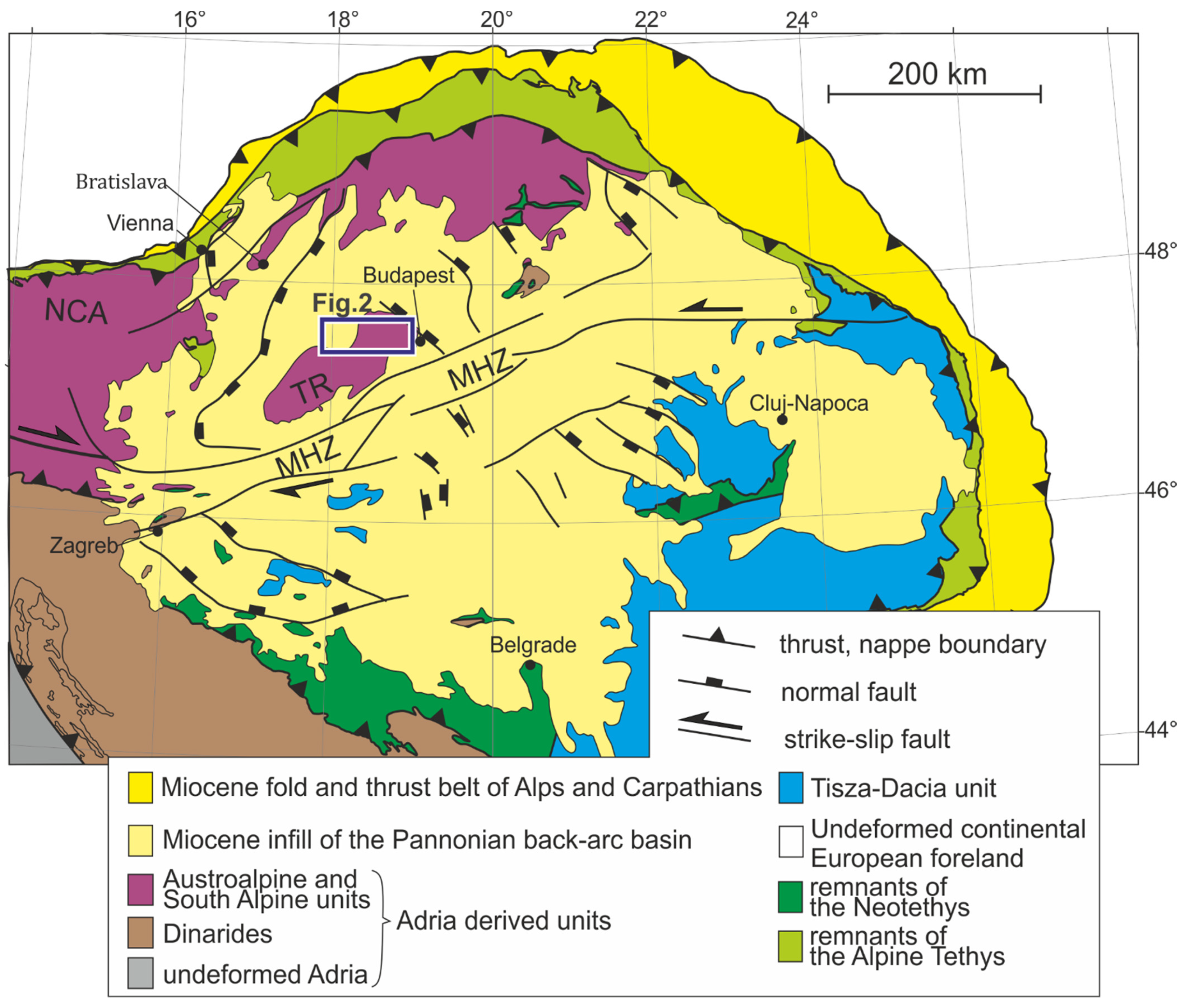

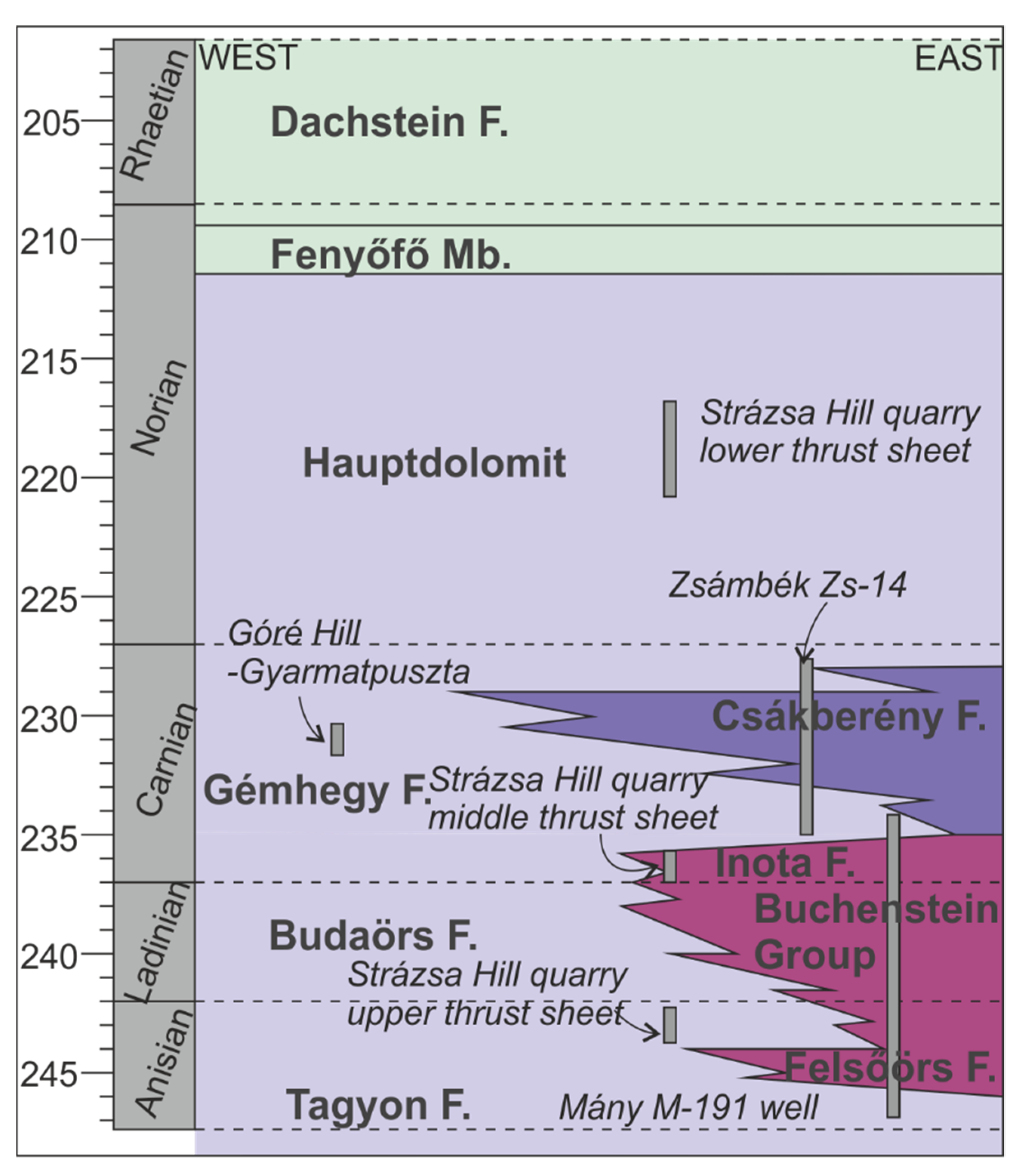

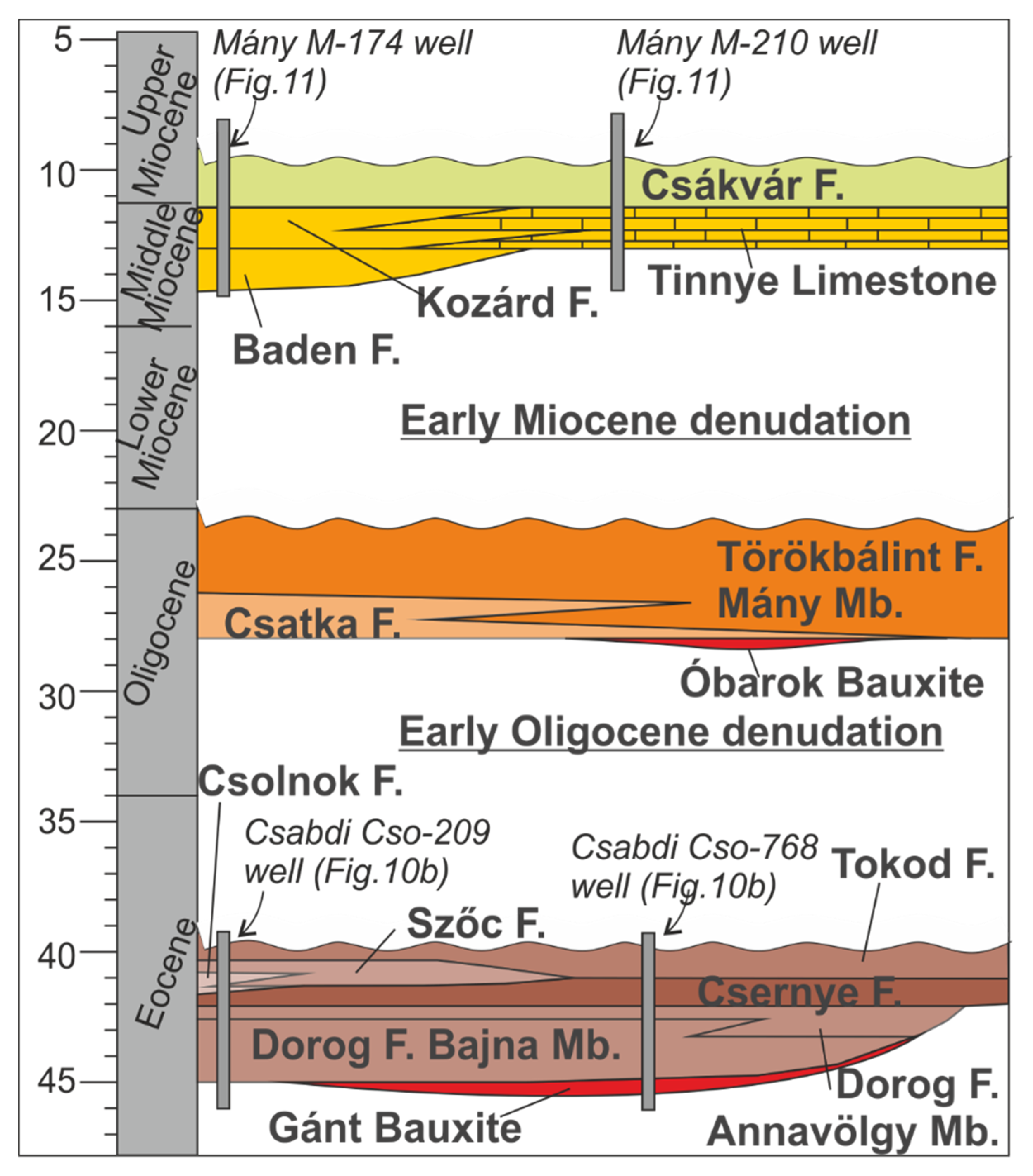


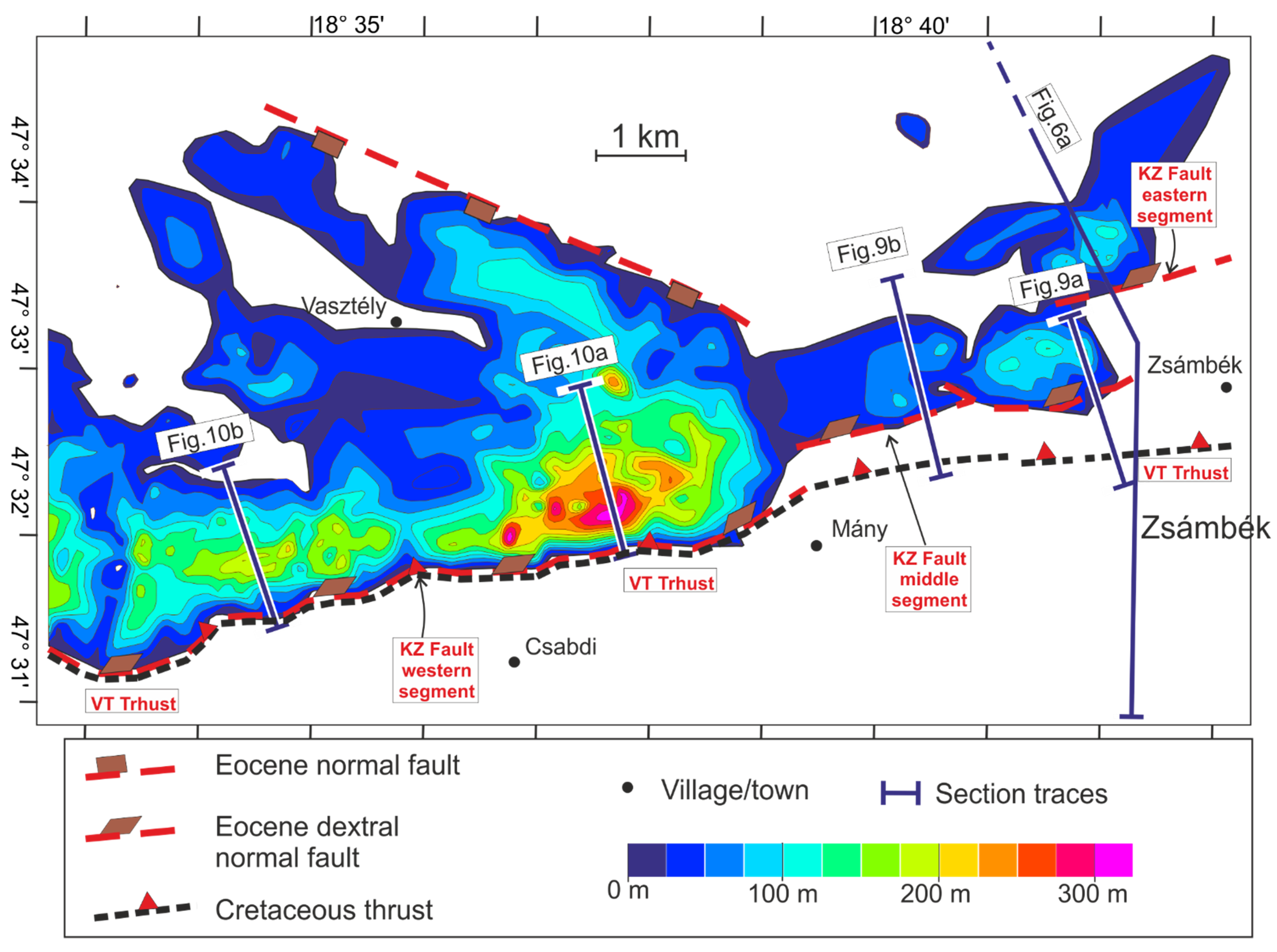
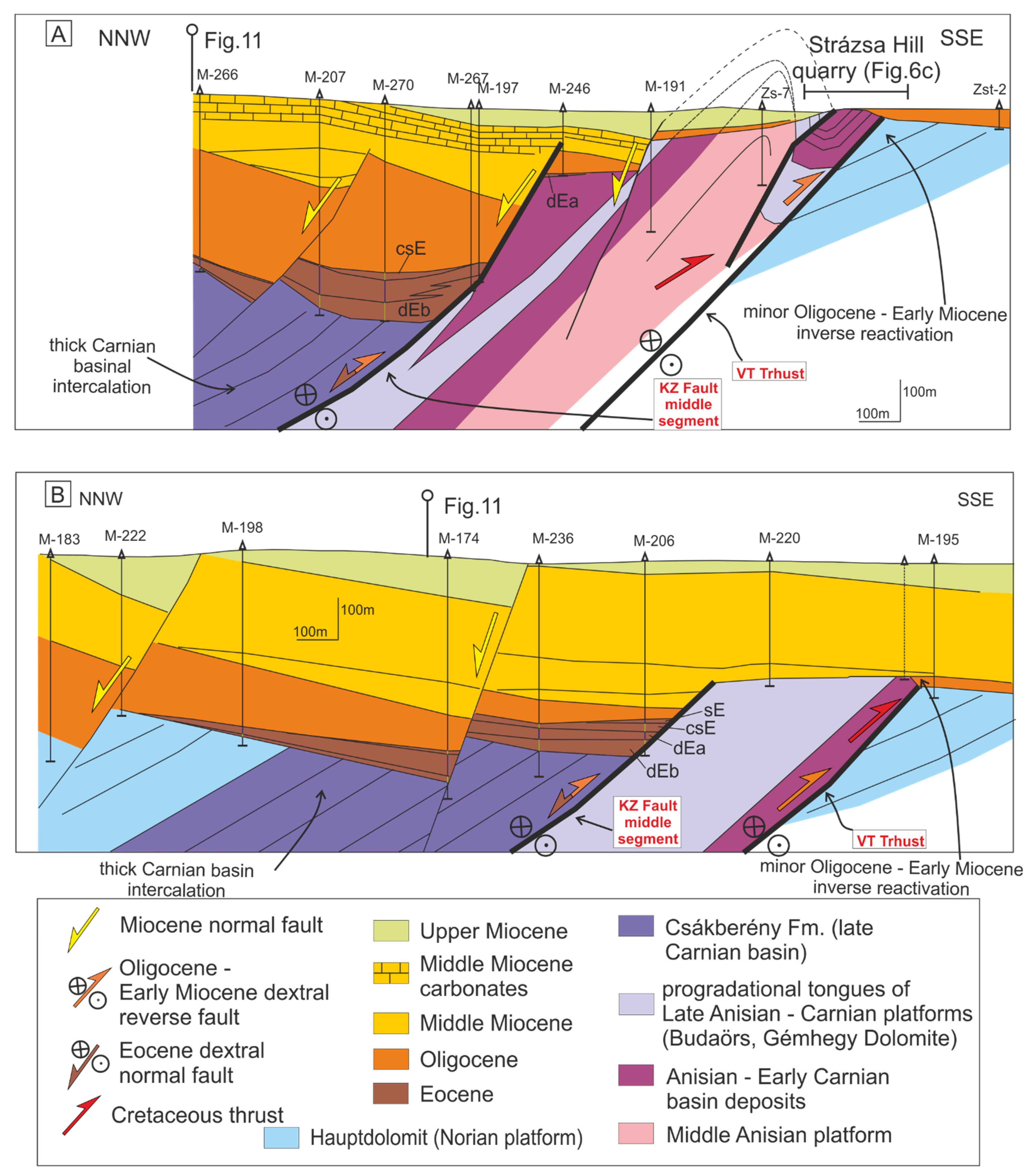
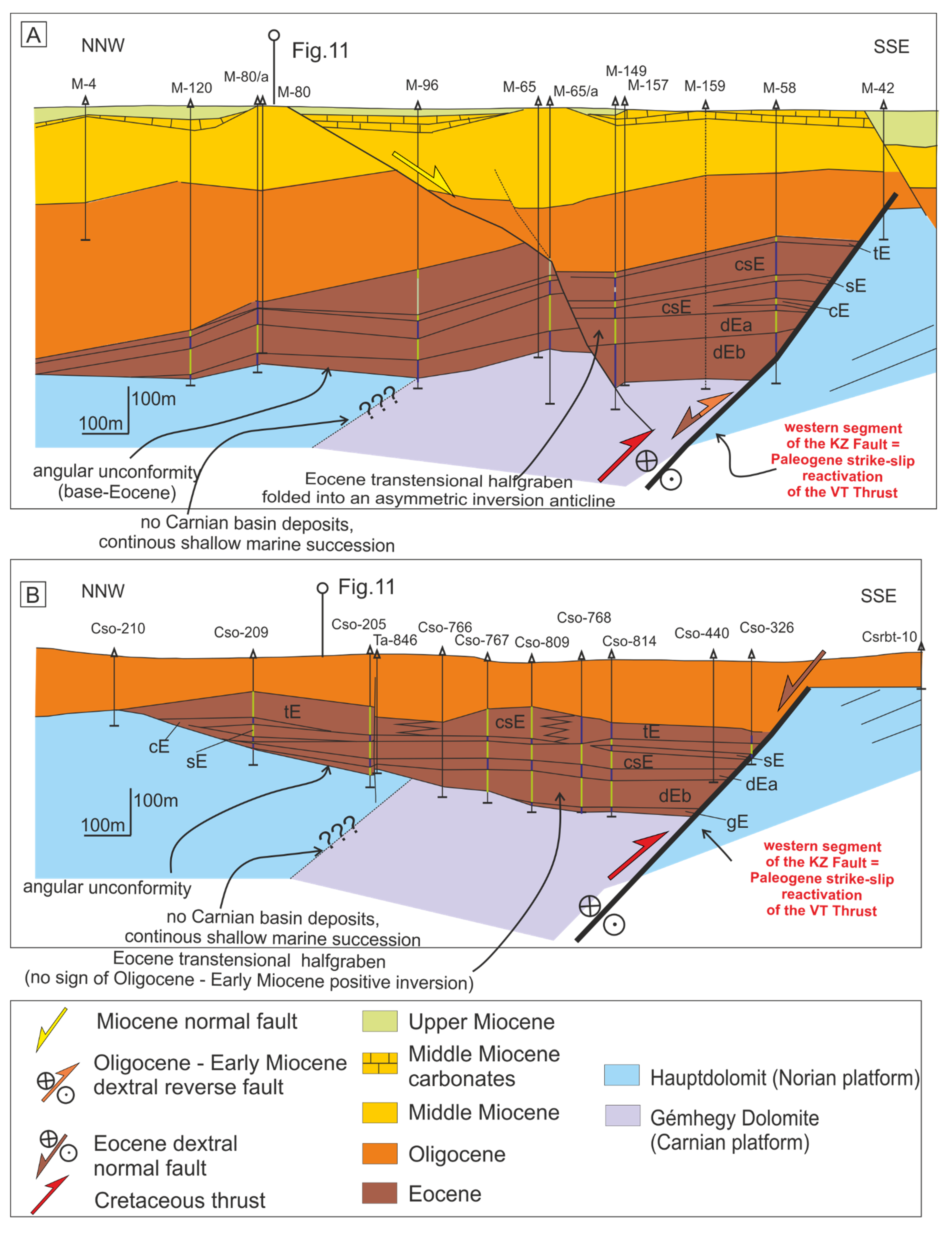

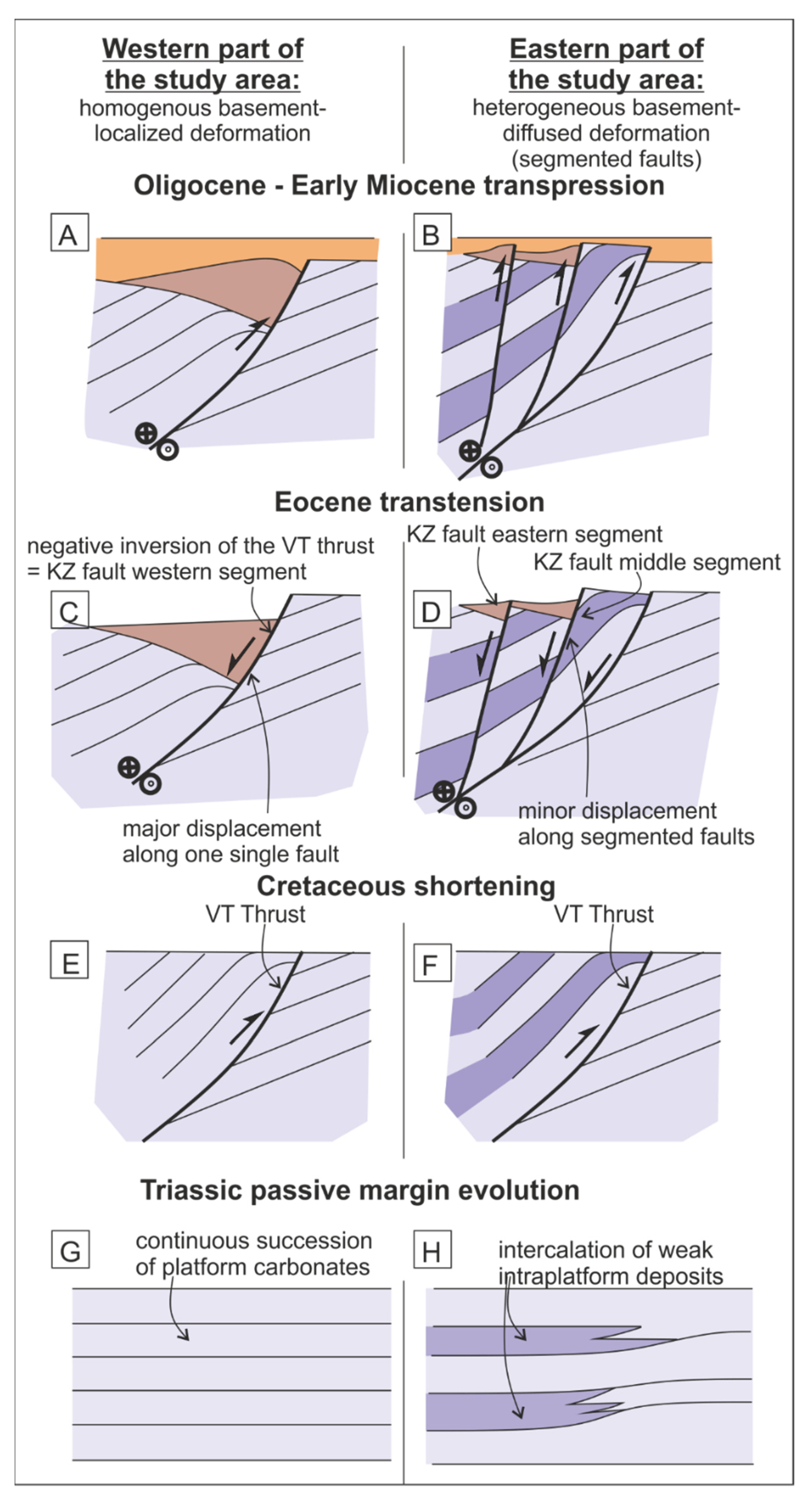
Publisher’s Note: MDPI stays neutral with regard to jurisdictional claims in published maps and institutional affiliations. |
© 2022 by the authors. Licensee MDPI, Basel, Switzerland. This article is an open access article distributed under the terms and conditions of the Creative Commons Attribution (CC BY) license (https://creativecommons.org/licenses/by/4.0/).
Share and Cite
Héja, G.H.; Kercsmár, Z.; Kövér, S.; Budai, T.; Noui, M.Y.; Fodor, L. The Role of Rheology and Fault Geometry on Fault Reactivation: A Case-Study from the Zsámbék-Mány Basin, Central Hungary. Geosciences 2022, 12, 433. https://doi.org/10.3390/geosciences12120433
Héja GH, Kercsmár Z, Kövér S, Budai T, Noui MY, Fodor L. The Role of Rheology and Fault Geometry on Fault Reactivation: A Case-Study from the Zsámbék-Mány Basin, Central Hungary. Geosciences. 2022; 12(12):433. https://doi.org/10.3390/geosciences12120433
Chicago/Turabian StyleHéja, Gábor Herkules, Zsolt Kercsmár, Szilvia Kövér, Tamás Budai, Mohamed Yazid Noui, and László Fodor. 2022. "The Role of Rheology and Fault Geometry on Fault Reactivation: A Case-Study from the Zsámbék-Mány Basin, Central Hungary" Geosciences 12, no. 12: 433. https://doi.org/10.3390/geosciences12120433
APA StyleHéja, G. H., Kercsmár, Z., Kövér, S., Budai, T., Noui, M. Y., & Fodor, L. (2022). The Role of Rheology and Fault Geometry on Fault Reactivation: A Case-Study from the Zsámbék-Mány Basin, Central Hungary. Geosciences, 12(12), 433. https://doi.org/10.3390/geosciences12120433








